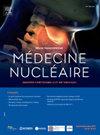Prise en charge du lymphome en médecine nucléaire chez l’enfant : actualisation et particularité des lymphomes chez l’enfant
IF 0.2
4区 医学
Q4 PATHOLOGY
Medecine Nucleaire-Imagerie Fonctionnelle et Metabolique
Pub Date : 2025-08-01
DOI:10.1016/j.mednuc.2025.06.006
引用次数: 0
Abstract
Pediatric lymphomas account for 10–15% of childhood cancers, with treatment approaches tailored to histological subtypes such as Hodgkin lymphoma (HL), and non Hodgkin lymphomas (NHL), including Burkitt lymphoma, diffuse large B-cell lymphoma (DLBCL), and primary mediastinal B-cell lymphoma. The introduction of 18F-FDG-PET imaging has significantly transformed diagnostic and therapeutic strategies. PET enables accurate initial staging, early response assessment, and contributes to treatment de-escalation, especially in HL through Euronet protocols. In Burkitt lymphoma, PET's role is limited due to the urgency of treatment, though its high negative predictive value (93%) is notable. Pediatric DLBCL, being less aggressive, allows for PET-guided management analogous to adult practice. In primary mediastinal lymphoma, common in adolescents, interpretation challenges arise from residual low-grade metabolic uptake post-treatment, often reflecting inflammation rather than active disease. FDG-PET has become essential in personalizing pediatric lymphoma care, refining staging, and reducing overtreatment. Combined with recent advances in targeted therapies – such as anti-CD20 antibodies and CAR-T cells – this approach improves survival outcomes while minimizing long-term toxicity.
儿童核医学淋巴瘤管理:儿童淋巴瘤的现状与特点
儿童淋巴瘤占儿童癌症的10-15%,治疗方法适合于组织学亚型,如霍奇金淋巴瘤(HL)和非霍奇金淋巴瘤(NHL),包括伯基特淋巴瘤、弥漫性大b细胞淋巴瘤(DLBCL)和原发性纵隔b细胞淋巴瘤。18F-FDG-PET成像的引入显著地改变了诊断和治疗策略。PET可以实现准确的初始分期,早期反应评估,并有助于治疗降级,特别是通过Euronet协议治疗HL。在伯基特淋巴瘤中,由于治疗的紧迫性,PET的作用有限,尽管它的高阴性预测值(93%)是值得注意的。儿童DLBCL的侵袭性较小,允许宠物指导管理,类似于成人实践。在青少年中常见的原发性纵隔淋巴瘤中,解释挑战来自治疗后残留的低级别代谢摄取,通常反映炎症而不是活动性疾病。FDG-PET已成为个性化儿科淋巴瘤护理、改善分期和减少过度治疗的必要手段。结合靶向治疗的最新进展,如抗cd20抗体和CAR-T细胞,这种方法提高了生存结果,同时最大限度地减少了长期毒性。
本文章由计算机程序翻译,如有差异,请以英文原文为准。
求助全文
约1分钟内获得全文
求助全文
来源期刊
CiteScore
0.30
自引率
0.00%
发文量
160
审稿时长
19.8 weeks
期刊介绍:
Le but de Médecine nucléaire - Imagerie fonctionnelle et métabolique est de fournir une plate-forme d''échange d''informations cliniques et scientifiques pour la communauté francophone de médecine nucléaire, et de constituer une expérience pédagogique de la rédaction médicale en conformité avec les normes internationales.

 求助内容:
求助内容: 应助结果提醒方式:
应助结果提醒方式:


